Uddeholm Vanax SuperClean - Knife
15.07.2024
The following is intended to describe, in detail, the processes and methods used to heat treat and manufacture a pair of Lance Clinton designed rigid fillet knives using the new Uddeholm Vanax SuperClean provided by Uddeholm. We will also get insight in the real life using and material sciences. The manufacturer of the knives is by Chad Kelly from C Kelly Custom Knives.
Conclusions about Uddeholm Vanax SuperClean based on the testing done are that it is a solid performer that is comparable in edge performance to Uddeholm Elmax and comparable grades. The Corrosion resistance are as good as 300 series stainless steel.
In addition, it seems to perform well with various heat treats as evidenced by the nearly identical performance between the three test knives.
| Blade material: Uddeholm Vanax SuperClean Hardness: 58-60 HRC Handel: G10 Design: Lance Clinton Manufacturing: C Kelly Custom Knives |
| Typical analysis % | C 0.36 | N 1.55 | Si 0.30 | Mn 0.30 | Cr 18.2 | Mo | V |
| Delivery conditions | Soft annealed to approx. 260 HB | ||||||
| Colour code | Grey / Dark blue | ||||||
Knife manufacturing
Creating the blanks
First, I used a template to trace the design shape on the steel and cut out the rough profile with a band saw. Once the blanks were roughly profiled I clamped the template to each and scribed the exact profile that I wanted. I then ground each blade profile into the desired shape. Next I clamped the template to each blank again and used it as a drill guide while I made holes for the handle hardware and lanyard.
With profiles and holes completed I moved on to preparing the surface of the steel and making the blanks as flat as possible. While grinding to make the steel flat, I brought the thickness of the steel down within the range that will provide the appropriate amount of flex for this design. This design calls for some flex but not nearly as much as a traditional fillet knife. One piece had slightly more twist in it than the other and required me to remove a little more material to get everything flat. By the time I was done I had one blank measuring .072” thick and the other measured .078” thick.
From this point forward I will refer to them as Blade #1(.072”) and Blade #2 (.078”).
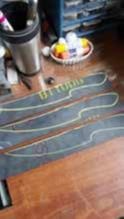
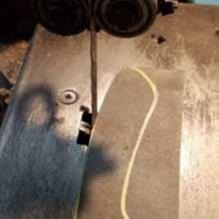
Next I epoxied some orange G10 to black peel-ply G10 for knife #1, and epoxied some grey G10 to black peel-ply G10 for knife #2. I did this so the two knives would be easier to distinguish from each other during testing. Prior to heat treating, I also had time to drill the hardware and lanyard holes in the handle material.
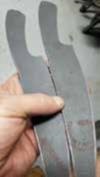

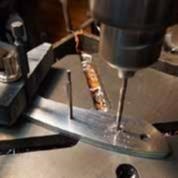
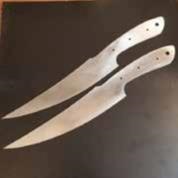
Heat treatment
Both blanks were placed in hi-temp stainless steel wrap. Seams are triple folded and crisply creased in order to provide a sealed environment. Due to the fact that some air is inevitably trapped in the envelope, a small piece of white paper is added with each blank. The paper will burn at 451F and use the remaining oxygen in the process.
H/T Protocol
- Pre-heat to 1600F, hold 5 min.
- Ramp quickly to 1975F, hold 30 min.
- Plate quench
- Submerse in Liquid Nitrogen, 24 hrs.
- Temper 2 hours, 2 times. (Blade #1 390F, blade #2 842F)
Blade #1
Blade went in the oven at 6:42 PM 11/17/17
Temp dropped immediately to 1441 F
Temp was back to 1600 F at 6:46 PM (4 min)
Temp held at 1598 F until 6:51 PM (5 min)
6:52 PM temp began to climb
7:12 PM Temp reached 1975F (20 min)
7:13 PM Temp 1971 F
7:14 PM Temp 1972 F
7:15 PM Temp 1972 F
7:16 PM Temp 1974 F
7:17 PM Temp 1975 F
Blade #2
Blade went in the 1606 F oven at 7:54 PM
Temp dropped to 1402 F
Temp returned to 1600 at 7:57 PM (3 min)
Temp held between 1597 and 1598 until 8:02 PM (5 min)
8:03 PM temp began to climb
8:17 PM temp reached 1975 F (14 min)
8:18 PM Temp 1973
8:19 PM Temp 1973
8:20 PM Temp 1974
8:21 PM Temp 1975
Grinding
Next step is to grind the main bevel. With plate quenched steel like this I heat treat the blade prior to any bevel grinding so the steel at the edge of the blade makes contact with the plates and cools at a rate equal to the rest of the blade. Grinding the entire bevel in hardened steel requires patience and water to make sure the edge doesn’t get hot.
Each blade consumed 1 new 36 grit ceramic belt to take the grind up to the spine. As the grind makes progress the blade is dipped in water increasingly more often until it eventually needs to be dipped after every grinding pass to ensure the edge doesn’t get hot. I did all of the grinding with bare hands and my thumb on the blade directly over the grind so I could feel the heat at all times.
After getting the grind up to the spine I used ceramic belts in 60, 80, & 120 grits to clean it up. Handle
With the blades ground it was time to finish the handles. Once the handles are finished the sheaths can be molded. Both sheaths are black and orange but I used silver grommets for the grey/black handle blade #2 so the sheaths do not get mixed up during testing. The only thing left to do is to sharpen them and move on to some basic edge testing.
Knife testing proccess
“My conclusion that based on the combination of corrosion resistance, wear resistance and toughness, Uddeholm Vanax SuperClean is currently without rival in the knife world. To make myself clear, I am a firm believer that there is no such thing as a “best steel”. Different steels have different characteristics which make some better or worse for various tasks. What I am saying is that if corrosion resistance is a priority but you don’t want to sacrifice edge performance then I don’t know of a better performing cutlery steel available. Bravo. “ Lance Clinton ”Surfingringo”
Field test
I received the new test knives from Chad. One with an orange handle that received the standard HT (1975F w/ 2x2hour tempers at 390F).The second one has a gray handle and had a new HT (1975F w/ 2x2 hour tempers at 840F). I will simply refer to these as the gray knife and the orange knife. The first thing I did was reprofile both new knives to exactly 15 degrees per side and then added a tiny 20 dps micro bevel. Initial sharpness was very high and both edges would firmly grab head or beard hair on contact (don’t laugh, that’s actually a very good sharpness test, haha). For the sake of comparison, I also sharpened the original test knife, a knife in lc200n/zifinit and a custom knife in cpm154 that tested at 61 HRC. Once all knives had been reprofiled to the same edge and the same degree of sharpness, I began testing.
I began the testing with cardboard where I would make measured sawing cuts into doubled 2 ply cardboard. I measured sharpness on each knife after every 20 cuts (each cut consisted of 5 back and forth sawing motions) and the falloff in sharpness was very similar between all 5 knives. After 100 of these cuts, all knives would still shave but were starting to lose their bite. I made 50 more cuts with each knife and at that point the 3 Uddeholm Vanax SuperClean knives and the cpm154 were holding a similar level of sharpness but the lc200n was starting to become dull. After 50 more cuts, the lc200n was getting to the point that it was no longer useful but the other 4 were holding a relatively useful “working edge”. I made 100 more cuts with each knife for a total of 300 each and at that point the lc200n had completely lost its edge and would no longer slice magazine print or typing paper. The vanax knives and the cpm154 knife had all lost much of their bite but would still slice magazine print with some occasional snagging.
As a final attempt to completely kill the edges, I then made 50 cuts with each through 5/8” hard polypropylene rope. After the testing was over, the lc200n knife no longer had a useful edge. Interestingly, the Vanax knives were all VERY close in sharpness. All of them would still slice magazine print with occasional snagging. The orange knife was the only one that would barely scrape shave so I would give it a slight nod in performance but the differences were so minimal that they could easily fall within the margin of error or be attributed to differences in the media cut or slight differences in initial sharpness. I did not see what I would call a meaningful difference in performance between the three knives. Even more interestingly, the cpm154 knife showed no advantage in retained sharpness over the Vanax knives. In my experience, cpm154 at 61 performs much like s30v, which performs much like Elmax, so based on my testing so far, I feel it is a fair claim to say that Vanax SC shows “Elmax-like” performance. None of the knives showed any signs of chipping though all were starting to show small areas of reflected light from flattening and dulling.
**Cardboard and rope are expedient ways to test edges in controlled conditions but they can’t tell you everything. I will hopefully be using both of these test knives at the cleaning table on some large fish in the near future. I will update my conclusions and opinions as I gather more data from real world use. I will try to get some nice action photos too.
I am writing to report my continuing observations on the performance of the two Vanax SC fillet knives. Starting 4 weeks ago, I mounted both of the knives on my saltwater fishing kayak and began testing for corrosion resistance and edge performance.
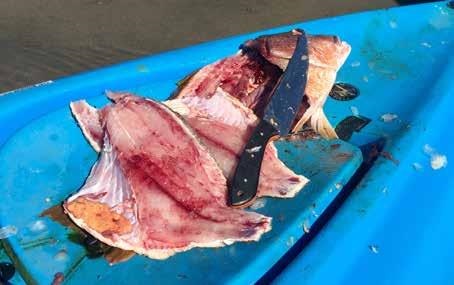
First, let me describe the environment in which I do my corrosion testing as I regularly use my kayak for testing the corrosion resistance of various steels. The knives are stored inside the hull of the kayak where there is always an inch or two of salt water. I also make sure to dunk the knives in saltwater every day and they sit on the deck of the kayak during my fishing then at the end of the day they go back into their saltwater bath where they live 24/7. The kayak is stored outside and the temperature inside the hull reaches well over 100 degrees Fahrenheit every day. This causes evaporation which helps the salt and moisture permeate every area of the knife. It is a torturous environment that will cause most any stainless steels to start showing corrosion spotting within 4-6 hours.
The corrosion resistance results of the two Vanax blades have been amazing. After nearly a month of 24/7 exposure, neither knife has shown ANY signs of rust, corrosion or staining. The one area where some rust was visible was underneath the handle but that is a common occurrence with any rust proof steel and is a result of the stainless hardware rusting and reacting with the Vanax. What should be noted is that the rust created by the stainless hardware did not seem to react with the Vanax and did not cause any corrosion or pitting on the blade steel at the areas where the steels contact each other. (I have observed this in some “rust proof” steels, including lc200n). I don’t want to make too much of this distinction yet as I need to do more testing but at this point I feel safe saying that Vanax SC is at least as rust proof as lc200n/zifinit/cronidor30 and possibly more so. Even after my torture testing I feel wholly confident calling Vanax SC a “rust proof” steel.
Edge performance on the kayak is a completely different exercise than cutting rope and cardboard in a controlled environment. The primary testing has been processing fish, most of which have been medium to large Snapper. It should be noted that Snapper are a great test for an edge and can dull a knife quite quickly. The scales of these fish are very hard...so hard that you can’t actually cut through them. The first cut behind the gill requires a couple of sawing motions that move the scales out of the way before being able to cut into the fish. The other challenge with Snapper is they have much heavier bones that some fish. There are rib bones that have to be cut through and the final cut to remove the fillets requires bumping the edge into the spine bones to find the right path. In addition, I removed the heads and gills of many of these fish for soup and this requires high force sawing and push cuts through hard bone and cartilage.
I tested the orange handle knife (390 temper) first. After cleaning six Snapper and removing the heads and gills of 3, the edge was still in great condition and would still easily shave in one pass. Comparing to some of my other fillet knives, that is outstanding performance and at least on par with steels like cpm154 and s30v. Next I began testing the grey handle knife. After the same amount of work that knife has become slightly more dull. The edge will still scrape shave but there are some areas of reflected light and one can feel some barely perceptible chips or divots when running a fingernail across the edge. I don’t want to make too much of this performance difference because there is nothing exact about testing on fish. Size of fish, placement of cut, pressure required, steadiness of hand and effect of that on lateral stress can all play a HUGE roll in how long an edge lasts so it is hard to draw really meaningful conclusions from just a few fish. After 6-12 months though I should be able to see a pattern in performance results and if the difference continues to hold true I will feel more confident in making a solid conclusion about edge performance. Having made that disclaimer though, I would say that the orange handle knife is showing better performance as a fillet knife so far.
Based on what I have seen so far and continue to see, I believe you guys have created an outstanding cutlery steel. It is my conclusion that based on the combination of corrosion resistance, wear resistance and toughness, Vanax SC is currently without rival in the knife world. To make myself clear, I am a firm believer that there is no such thing as a “best steel”. Different steels have different characteristics which make some better or worse for various tasks. What I am saying is that if corrosion resistance is a priority but you don’t want to sacrifice edge performance then I don’t know of a better performing cutlery steel available. Bravo!
This article was written by
Chad Kelly, C Kelly Custom Knives
Lance Clinton “Surfingringo”
Uddeholms AB
More information:
voestalpine High Performance Metals International GmbH
office.hpm_international@voestalpine.com
www.voestalpine.com/hpm/international/en/




































